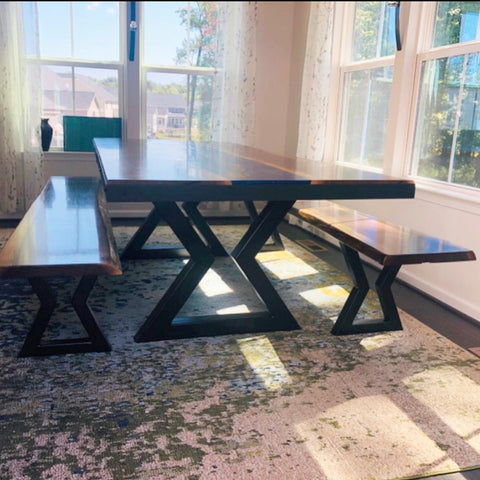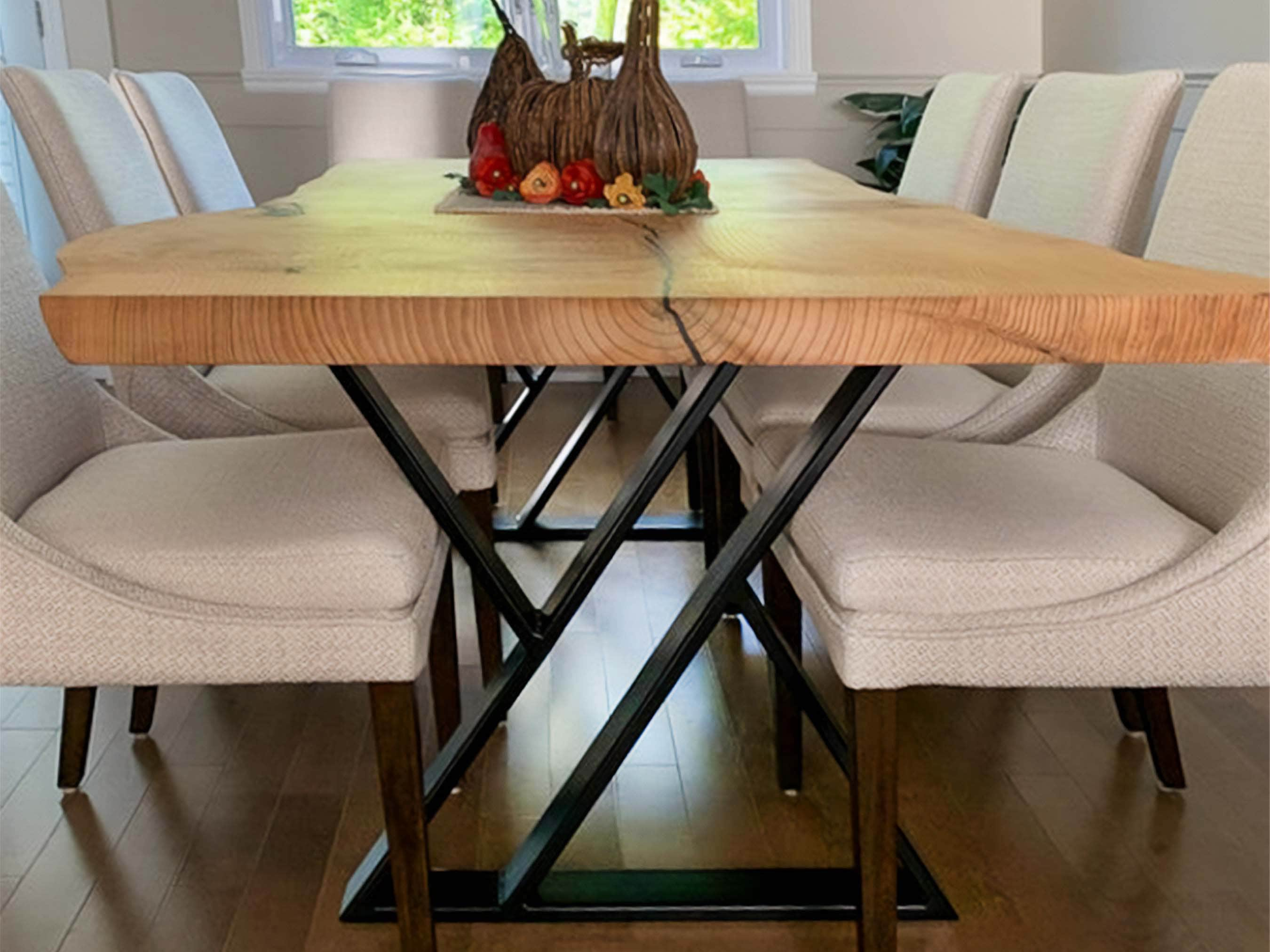The Top Trends in Dining Room Table Legs You Need to Know
The Top Trends in Dining Room Table Legs You Need to Know
Blog Article
From Conventional to Modern: Locate the Suitable Dining-room Table Legs for Your Design
While traditional styles such as cabriole and turned legs evoke a feeling of timeless elegance, modern styles like hairpin and geometric alternatives present a chance for striking visual rate of interest. As you take into consideration these elements, the concern remains: just how can you seamlessly integrate these varied leg designs to develop a harmonious dining experience?
Understanding Table Leg Styles
The selection of dining space table leg styles can dramatically affect both the aesthetic appeals and functionality of the space. Each leg style adds unique functional attributes and visual aspects, accommodating diverse design choices and use needs. Recognizing these designs is vital for picking the right eating table that lines up with your total interior decoration vision.
For circumstances, conical legs supply a tidy, traditional look that can enhance a space's elegance, while stand bases supply security and take full advantage of legroom, making them excellent for smaller sized areas. Hairpin legs, a trademark of mid-century modern design, present a commercial style, permitting an airy, open feeling. In a similar way, trestle legs evoke rustic beauty, supplying durable support and a sense of timelessness.
In addition, the option of products plays a considerable duty. Wood legs can bring warmth and appearance, whereas metal options often share a streamlined, contemporary ambiance. Eventually, recognizing table leg styles is vital for creating a natural eating location that mirrors individual style while ensuring functionality and comfort. By attentively considering these aspects, you can enhance both the visual and useful charm of your eating room.
Traditional Table Leg Options
When choosing eating area table legs, conventional options frequently embody timeless elegance and workmanship. These styles reflect a rich heritage and a dedication to high quality, making them suitable for those who appreciate traditional aesthetics.
Among the most legendary standard leg designs is the cabriole leg, characterized by its elegant bent form. This layout commonly features ornamental carvings and is most commonly found in Queen Anne and Chippendale furnishings. Another popular choice is the transformed leg, which boasts a collection of smooth, rounded shapes that supply a classic look while preserving security.
Furthermore, the straight leg, while simple, provides a unadorned and sturdy structure that can mix flawlessly with a range of tabletop designs. For those attracted to ornate outlining, claw-and-ball feet legs evoke a sense of grandeur and can serve as a sensational centerpiece in any dining area.
Last but not least, stand bases, although not strictly legs, offer an alternate standard option that permits sufficient legroom and can be magnificently carved. Each of these typical leg styles contributes to the general setting of a dining space, weding feature with visual charm.

Modern Table Leg Layouts
Modern table leg styles use a varied array of styles that highlight ingenious products and clean lines. These layouts usually prioritize functionality while working as striking focal factors within a dining space. Minimal looks are widespread, with legs crafted from products such as metal, glass, and engineered wood, which add to a modern and airy feeling.
One prominent layout is the barrette leg, characterized by its slender, conical structure that offers stability without frustrating the table top (dining room table legs). This design is commonly discovered in mid-century contemporary furniture and can effortlessly enhance different table shapes. Another pattern is making use of geometric forms, where legs might take on unbalanced or angular kinds, including visual passion and a touch of virtuosity

Blending Styles for Unique Rooms
Often, house owners seek to create unique eating rooms that show their personal style by blending various design components. other This strategy enables the unification of varied aesthetics, causing an unified yet unique environment. For Learn More Here example, matching a rustic wood table with streamlined, contemporary metal legs can produce an appealing comparison that elevates the area's general appeal.
Furthermore, incorporating vintage table legs with modern table tops can stimulate a feeling of background while keeping a contemporary sensibility. Such mixes not just display individual preference however also motivate creativity, allowing homeowners to curate an area that feels both individual and welcoming.
Color plays a crucial duty in this mixing process; selecting table legs that match or comparison with the existing color design can improve aesthetic rate of interest. For example, whitewashed legs can soften the daring of a dark table surface area, creating a well balanced visual.
Tips for Selecting the Right Legs
Picking the right table legs is necessary for accomplishing both capability and aesthetic charm in your eating room. Begin by thinking about the overall style of your space. Traditional settings profit from legs that include complex makings or turned designs, while contemporary areas might require streamlined, minimal designs.
Following, assess the height and security of the legs. dining room table legs. Standard table vary in between 28 to 30 inches in elevation, so make sure the legs match this dimension for convenience. In addition, robust materials, such as wood or steel, can boost stability and long life
Evaluate the leg shape also-- choices consist of straight, tapered, or stand styles. Straight legs use a timeless look, while tapered legs can add a touch of style. Pedestal bases supply adequate legroom and are suitable for smaller sized spaces.
Verdict
In recap, selecting the ideal dining-room table legs needs cautious consideration of both modern and conventional styles. pop over to this web-site Traditional options such as cabriole and transformed legs supply timeless sophistication, while contemporary layouts like hairpin and geometric shapes provide a modern touch. By balancing leg design, elevation, and material with the general design, a cohesive and inviting environment can be attained. Ultimately, the picked table legs ought to mirror the preferred aesthetic, boosting the eating experience within the area.
The selection of dining space table leg styles can significantly affect both the aesthetic appeals and capability of the area. Inevitably, understanding table leg designs is important for developing a cohesive dining area that shows personal style while making sure practicality and convenience.One of the most renowned traditional leg styles is the cabriole leg, identified by its graceful bent shape. Straight legs offer a timeless look, while tapered legs can add a touch of style.In summary, choosing the optimal dining space table legs needs careful factor to consider of both modern and conventional styles.
Report this page